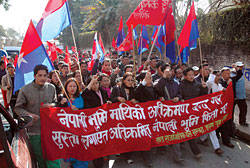|
|
| TOKEN PROTEST: Student unions affiliated to the seven parties at the Indian Embassy last week to protest alleged encroachment by India at Susta. |
The border between Nepal and India is shaped like the jagged teeth of a rusty saw. It is difficult to demarcate, tricky to measure and complex to map. Overcoming all these challenges, the Nepal-India Joint Technical Level Boundary Committee declared in 2005 that the two countries shared a common border of 1,880km.
Disagreements over the location of boundary pillars and claims of encroachment are rare along the 1,240km-long, 10-yard-wide strips of no man's land. However, 640km of the border runs through meandering river beds that change course every few years. When old river courses dry out, and grabbers on both sides claim public land for private use.
The Susta story is more complex. Susta-Triveni was a sleepy settlement in Nawalparasi until the government decided to populate it with retired soldiers in the early 1960s, following King Mahendra's order to inhabit villages along the international border west of the Bagmati with hardcore loyalists of the Panchayat regime.
Most beneficiaries of this royal munificence were pahadis from the middle hills. They dreaded the prospect of living in the malarial swamps of Susta. Fallow fields were soon sold to speculators from Butwal, Chitwan and beyond. To these distant owners, the land was not sacrosanct matribhumi but merely property of uncertain productivity that could be bought or sold at will. Rather than moving there themselves, the new owners sent poor tenants to cultivate their holdings.
Settlers from the hills had no emotional attachment to what was for most of them alien terrain. Meanwhile, most displaced madhesis had crossed the border and found shelter in Bihar and Uttar Pradesh, from where they still hold a grudge against pahadi settlers who turned them from landowners into squatters.
Mahendra soon realised this policy was a failure. He shifted his attention to Chure-Bhabar and the Inner Tarai for a colonisation drive conducted with American money and Israeli expertise. But along with greedy compromises over the Gandaki and Kosi (Mahendra was personally involved with both these deals), strategic blunders such as Susta and Bhantabari were transformed into metaphors for Nepal's fragile nationhood. So whenever rulers in Kathmandu need to divert public attention from domestic failings, a chorus over Kosi, Gandaki or Susta is carefully orchestrated with the help of useful idiots in the communist parties.
This is the reason why UML radicals and YCL hooligans get so worked up over what is essentially a technical issue to be resolved on the basis of authoritative documents. But what did the regime want to hide this time by reactivating the 'Susta Occupation' slogan?
Rajendra Mahato publicly charged that the SPA government was trying to downplay grievances of madhesis by unnecessarily ratcheting up Susta. Some influential NC leaders believe the Maoists just want to refurbish their nationalist image and erase their close association with India from public memory by raising the emotive issue of contested boundary pillars.
Publicly, leftist parliamentarians are more vocal than anyone else over Susta-after all, it was almost their monopoly till recently. But in private, UML stalwarts admit that reactivation of the Tanakapur and Susta issue at this juncture will be counterproductive.
Taking her cue from Balkhu, Foreign Minister Sahana Pradhan directed Shital Nibas mandarins to devise damage control measures. Early this week, MoFA announced that Nepal and India have agreed to maintain the 1968 status quo over Susta and Kalapani. The implication is that the legacy of Mahendra will still be available whenever some populist has an urge to air their insecurities in the guise of patriotism.
The border uproar will probably die down in a few days. But as long as the Nepali psyche needs a regular fix of jejune jingoism, the last sigh of Susta will never be heard.




